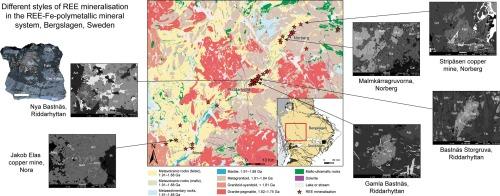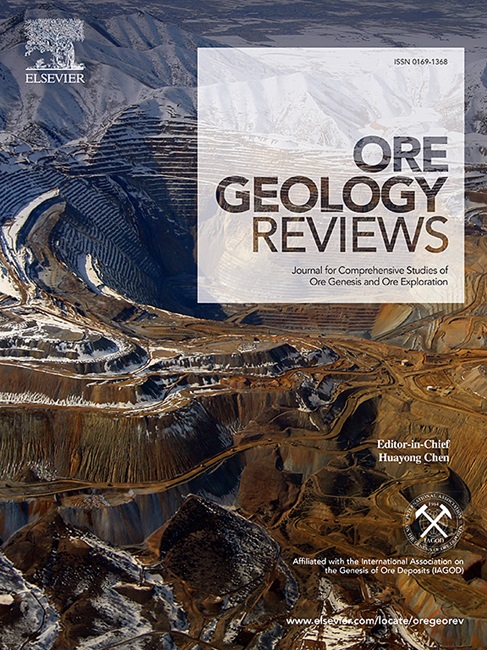瑞典 Bergslagen REE 线的 REE-Fe 多金属矿物系统综述:新的矿物学和纹理-成因制约因素
IF 3.2
2区 地球科学
Q1 GEOLOGY
引用次数: 0
摘要
稀土元素(REE)在众多技术中的重要性与日俱增,尤其是在当今快速发展的 "绿色转型 "应用中,如风力发电机和电动汽车牵引引擎。在瑞典比较著名的 REE 矿化类型中,还有碱性侵入体和磷灰石-氧化铁矿石,即经典但神秘的 Bastnäs 型 REE-Fe 多金属矿系统。该矿化类型是区域性的,出现在瑞典古生代 Bergslagen 矿区中西部的一条不连续的西南-东北走向矿带(REE-line)中。本文旨在整合和综合现有的地质、矿物学和纹理特征,以及对该矿带中著名和几个鲜为人知、勘探不足或以前未被承认的 REE 富集矿点的新观察结果,并结合矿物系统建模讨论主要特征。无论是在整个 REE 线上的区域范围内,还是在不同矿区或矿田的局部范围内,REE 矿化的风格和丰度以及离散 REE 矿物学都存在相当大的差异。这些差异还横向延伸到不同地层内部或不同地层之间,以及不同的母岩内部,主要是矽卡岩蚀变的偏碳酸盐岩,但也有不同蚀变的长粒变质火山岩。许多矿化物具有相似的纹理特征,记录了REE矿物在多个形成或置换阶段的漫长演化过程。最早被确认的 REE 组合具有细粒铈镧矿(CeCa),以及少量的姥钠石(Ce)-姥钠石(La)或氟闪长岩(Ce)-氟闪长岩(Y),或局部的闪长岩(Ce)-闪长岩(Y)矿物。这些集合体通常显示出褶皱集合体中出现的正方体-粒状纹理,所有这些都表明在斯维科卡累利阿造山运动早期阶段形成的 REE 矿物在区域变质过程中发生了重结晶和韧性变形。绿帘石类矿物的叠加生长和横切脉状特征很可能代表了这一造山运动演化过程中 REE 矿化和(再)移动的不同阶段。几个富含 REE 的矿点含有丰富多样的多金属铜-钼-双(钴)硫化物矿化物,这些矿化物通常出现在晚期成因位置,并显示出富含 REE 组合的普遍性,通常以不同的绿帘石族矿物为主。硫化物和 REE 矿化在局部地区与变质矿物密切相关,这些变质矿物是在不同的镁-(铁)变质的变质火山岩变质过程中形成的。REE 矿化风格和强度的多样性,以及质地和特定矿物学的变化,表明矿化时的成矿条件或环境略有不同。此外,这些差异还可能反映了斯维科卡累利阿造山运动演化后期的保存或改造过程的变化,其中也包括 REEs 和硫化物矿物的再移动。本文综合了从微观尺度到全省尺度的所有可用证据,从中获得的启示有助于确定勘探制图的关键代用指标。综合证据表明,该矿物系统的主要矿石形成阶段与1.9 Ga左右的长岩火山活动及相关的次火山至深成岩过程相吻合。本文章由计算机程序翻译,如有差异,请以英文原文为准。

A synthesis of the REE-Fe-polymetallic mineral system of the REE-line, Bergslagen, Sweden: New mineralogical and textural-paragenetic constraints
Rare earth elements (REE) have gained increasing significance for numerous technologies, particularly in today’s rapidly expanding “green transition” applications such as wind generators and electric vehicle traction engines. Among the more well-known REE mineralisation types in Sweden, together with alkaline intrusions and apatite-iron oxide ores, is the classic yet enigmatic REE-Fe-polymetallic mineral system of Bastnäs-type. The mineralisation type is regional in context and occurs in a discontinuous SW–NE-striking belt (the REE-line) in the west-central part of the Palaeoproterozoic Bergslagen ore province, Sweden. This contribution is aimed at integrating and synthesising existing geological, mineralogical, and textural features with new observations from both well-known and several lesser-known, underexplored or previously unrecognised REE-enriched occurrences within this belt, and to discuss key features within the context of mineral systems modelling. A considerable diversity in both the style and abundance of REE mineralisation as well as in discrete REE mineralogy is evident both regionally across the entire REE-line and locally within different ore districts or mine fields. These variations also extend laterally within or across different stratigraphic levels, and within different host rocks, primarily skarn-altered metacarbonates but also variably altered felsic metavolcanic rocks. Many of the mineralisations share similar textural features, which record a protracted evolution with multiple stages of formation or replacement of REE-minerals. The earliest recognised REE assemblages feature fine-grained cerite-(CeCa) with minor bastnäsite-(Ce) – bastnäsite-(La) or fluorbritholite-(Ce) – fluorbritholite-(Y) or locally britholite-(Ce) – britholite-(Y) minerals. Such assemblages typically display anhedral-granoblastic textures appearing in folded assemblages, all suggesting recrystallisation and ductile deformation during regional metamorphism of REE-minerals that had formed during an early stage of the Svecokarelian orogeny. Overprinting overgrowths and cross-cutting vein-like features of allanite-group minerals likely represent different stage(s) of REE mineralisation and (re)-mobilisation during this orogenic evolution. Several of the REE-enriched occurrences contain variably abundant and diverse polymetallic Cu-Mo-Bi-(Co) sulphide mineralisation that typically occur in late paragenetic positions and show a prevalence to REE-rich assemblages, often dominated by different allanite-group minerals. Sulphide and REE mineralisation are locally strongly associated with metamorphic minerals formed during metamorphism of variably Mg-(Fe)-altered metavolcanic rocks. The diversity in style and intensity of the REE mineralisations, along with variations in textures and specific mineralogy, suggest slight differences in the ore-forming conditions or environment at the time of mineralisation. Additionally, these differences may also reflect variations in the preservation or modification processes that operated later in the evolution of the Svecokarelian orogeny, also featuring remobilisation of REEs and sulphidic minerals. The insights gained from all available evidence synthesised herein, from micro-scale to province-scale, help define key proxies for prospectivity mapping. The combined evidence supports that the primary ore-forming stages in the mineral system coincided with felsic volcanism and associated sub-volcanic to plutonic processes at around 1.9 Ga.
求助全文
通过发布文献求助,成功后即可免费获取论文全文。
去求助
来源期刊

Ore Geology Reviews
地学-地质学
CiteScore
6.50
自引率
27.30%
发文量
546
审稿时长
22.9 weeks
期刊介绍:
Ore Geology Reviews aims to familiarize all earth scientists with recent advances in a number of interconnected disciplines related to the study of, and search for, ore deposits. The reviews range from brief to longer contributions, but the journal preferentially publishes manuscripts that fill the niche between the commonly shorter journal articles and the comprehensive book coverages, and thus has a special appeal to many authors and readers.
 求助内容:
求助内容: 应助结果提醒方式:
应助结果提醒方式:


